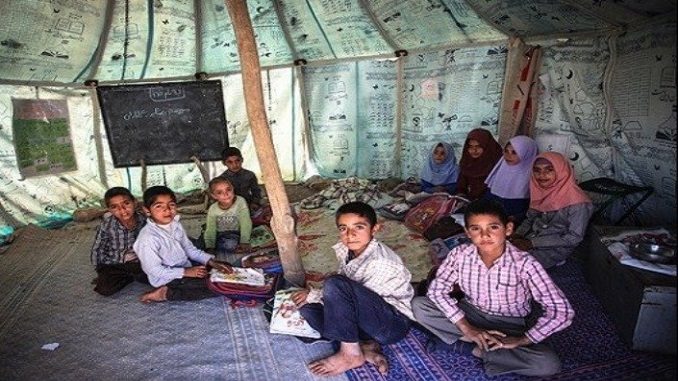
Similar to the Turks, Kurds, Lors and Persians, Arabs live as the original inhabitants throughout Iran. The Arabs did not only live on the coast of the Arabian Gulf, its islands and the “Arabistan of Ahwaz” or “Khuzestan” provinces as they are officially called by the government, but the Arabs relatively inhabit Fares, Kerman, Khorasan, Samnan and Ilam provinces, Al Arabiya reports.
Some documented historical research and studies confirm that Arabs lived in Iran hundreds of years before the Arab-Islamic conquest, where they lived in areas in central Iran such as Kerman governorate. Arabs live in Ilam governorate where the Kurdish represents the majority of its population; not in “Dja Abbas” area next to the Arabistan of Ahwaz province, but the far north of Ilam in a remote mountainous region located south of Kermanshah province, western Iran.
There is a group of Arab villages in this Kurdish area called “Arab Riwar” in Kurdish or “Arab Rodbar” in Persian; “Riwar” means the river, where the Arabs live on the banks of the “Simra” river which flows towards Arabistan province referred to by Arabs as “The Karkhah River”. These Arabs live side by side with the Kurds in a peaceful and fraternal atmosphere.
According to some studies, the population of these villages who speak Arabic as well as the Kurdish, originally belongs to Bani Asad tribe, but there is no documented research to confirm this.
The Arabs work in agriculture in Jum Shar, Jarouta and Dar Balut villages where their land is one of the most fertile in the region. According to the Iranian Radio and Television website, the flourishing of agriculture in this area has prevented the migration of its population, especially from the youth.
These villages produce about 15,000 tons of rice, maize, wheat, barley, pomegranate and vegetables annually.
It is worth noting that these Arab villages belong to the predominantly Kurdish city Sirwan, but the population is concerned that the number of Arabic speakers has slowly declined in favor of the Kurdish language. This is due to the fact that these villages are isolated in the high mountains of Zagros from the heavily Arab populated areas such as Arabistan. However, reports on these isolated villages, which are hundreds of kilometers away from other Arab regions, confirm that they cherish their Arab identity and strive to preserve the features of their national heritage.
This is preventing non-Persian nationalities to teach their languages in Iran, although the Iranian Constitution in Article 15 declares this right which has been suspended since the victory of the 1979 revolution.
There have been multiple cases of students being openly humiliated for speaking in their native language Arabic, as teachers forbid the use of the language inside Iranian classrooms. Just recently, two young girls were punished for speaking Arabic with each other. Although the teacher has since apologized, it further remains that this is not an isolated case, as state-induced discrimination and forced assimilation of ethno-linguistic minorities in Iranian schools forces many students to discontinue or lag behind in their education.
UNESCO concentrates on the necessity of the mother tongue in the education and direct connection between education in mother tongue and sustainable development. However, for millions of ethnolinguistic minority communities in Iran education in their mother tongue and having a multilingual education system is a dream.
The Ahwazi Centre for Human Rights (ACHR) welcomed in October the report of Ms. Asma Jahangir, the United Nations Special Rapporteur on Human Rights in Iran on the persecution and discrimination that taken and continuously happening in Al-Ahwaz. The report of Ms. Jahangir was submitted to the UN General Assembly (UNGA72) and in paragraph 100 that was written About Al-Ahwaz, Ms. Jahangir stated:
“The Special Rapporteur received detailed information about the reported persecution of the Arab ethnic minority in the Islamic Republic of Iran known as the Ahwazi Arabs, which included allegations of a change in the ethnic composition of the region through the confiscation of land and the establishment of settlements. Information about 45 cases involving the arrest and detention of Ahwazi Arabs was transmitted during the reporting period. Most of the cases seem to have taken place after participation in cultural and traditional events or protests against environmental degradation. In May, three Arab ethnic rights activists, Issa Damni, Mojahed Zargani and Hossein Heydar, were sentenced to a year in prison by branch 4 of the revolutionary court in Ahwaz for organizing Arabic-language classes and promoting ethnic rights.”
in similar context, The Kingdom of Saudi Arabia by representation of Mr. Khaled Manzlawi condemned the persecution of the Ahwaz Arab by the Iran regime in a statement during the UN Third Committee’s discussion on the report of the UN Special Rapporteur on the situation of human rights in Iran. In the Saudi statement, Mr. Manzlawi said:
“There are no positive signs indicate the near treatment of injustice and persecution suffered by Ahwazi Arabs and the confiscation of their Arab identity by Iranian authorities”.
